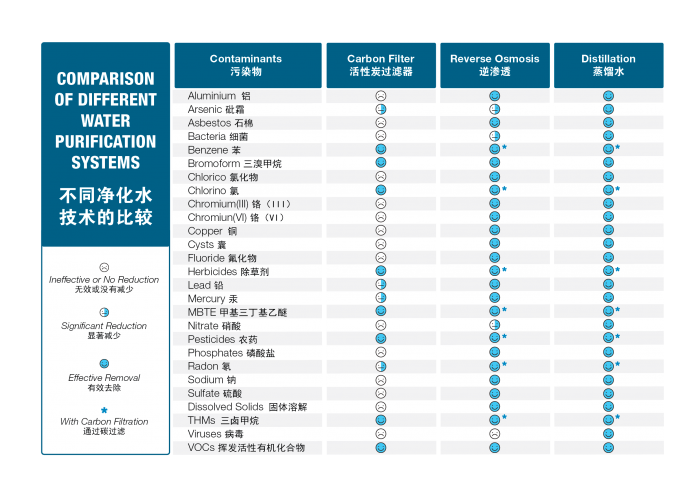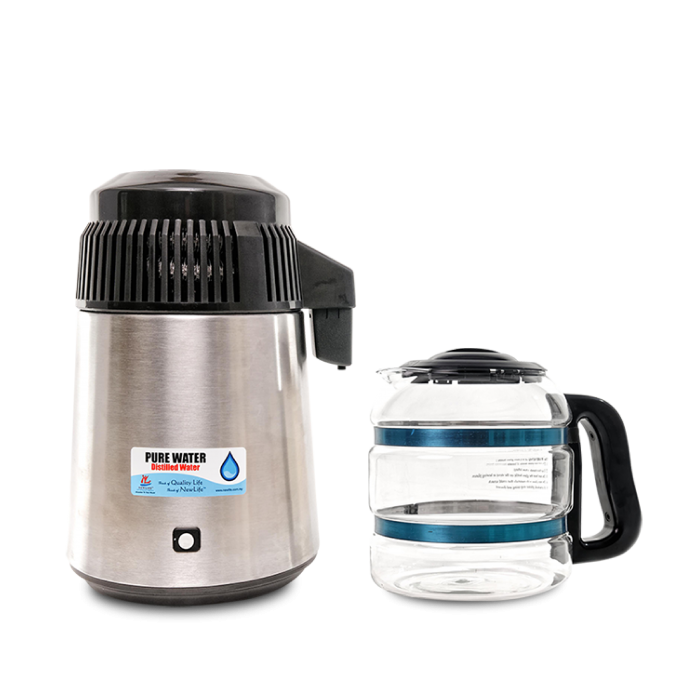Water plays a crucial function in transporting nutrients throughout the body, eliminating waste, regulating internal body temperature, and much more. For the body to function properly, it requires, on average, up to 3 litres of water per day. Given the obvious importance of water and the large amounts we consume, we should carefully consider whether we are drinking the right type of water.
Filtered Water vs. Reverse Osmosis Water
-
Distilled Water
Filtered water is tap water that has been run through a fine strainer or activated carbon. This process may improve the taste of tap water and filter out some forms of dissolved pollutants but is ineffective for removing most of the contaminants, including nitrates, parasites, bacteria and viruses. Also, water quality tends to reduce over time as filters decay and can become a breeding ground for bacteria.
Reverse Osmosis (RO) water is water that has been forced under high pressure through a synthetic semipermeable membrane. While effectively removing most inorganic minerals and pollutants from water, the quality of RO water is affected by many factors such as water pressure and temperature, bacteria, pH, dissolved solids, and chemical contaminant levels. Also, RO membranes can become clogged over time, leading to reduced water quality. They need to be replaced periodically and membranes are expensive. Another major concern is water wastage—even the best home RO systems use 3 litres of water for every 1 litre produced.
Distilled water is the purest form of drinking water. Distillation follows nature’s water purification cycle: water is boiled into steam which is run through a condenser to be converted back into water. In this process, distillation destroys or removes 100% of all impurities—chemicals, bacteria, viruses, pollutants, pesticides, lead, etc. You can be assured that you are getting 100% pure water all the time.

Some Myths about Distilled Water
Distilled Water Has No Nutrients
Some people criticize that distillation removes all the minerals from the water. This comes from a misunderstanding on how minerals work with the body.
Yes, minerals are essential for the basic functions of the human body. They help to control bone growth, regulate fluids, normalize nerve and muscle functions, maintain metabolism, grow connective tissues and more. But many may not realize that there are two types of minerals: organic and inorganic. Here is a brief overview of the differences between these two:
Organic minerals―these come from living things such as plants and animals. They contain carbon, and their electrons spin clockwise, just like those of the human body. Additionally, these cells can form an ionic bond with the body and can easily break down into materials to help with bodily functions, such as tissue repair.
Inorganic minerals―these are found in non-living things such as soil, sand and stone. They are picked up in the water as the water runs through the ground. They are without carbon and cannot bring life to cells. These materials are tightly held together and are not easily broken down. Their electrons spin counter-clockwise, out of sync with the human body. These inorganic, non-living minerals cannot be utilised by humans or animals, and can in fact, be harmful. Only plants can turn inorganic materials into organic minerals through photosynthesis.
The food chain shows how energy is transferred from one living organism to another. Our body is a living organism and the nutrients and minerals we consume must come from living sources. When we eat a healthy diet that includes various vegetables, fruit, whole grains, beans, nuts, lean protein, dairy products and nutritional supplements, we are likely consuming all the healthy, organic minerals we need.
In contrast, the minerals in water are inorganic, without life, and cannot be fully absorbed by the body as they cannot pass through the cell walls. Instead, they are deposited in other areas of the body. This process can cause numerous negative effects, including joint pain, arthritis, clogged arteries and gallstones.
To understand how detrimental inorganic minerals can be to the body, we need only to look at our plumbing fixtures. Calcium carbonate or lime is a common inorganic mineral, which creates deposits on fixtures, bathtubs, and showers. These deposits require special cleaning products to remove them and can cause permanent damage to fixtures.
Now, imagine the amount of inorganic minerals deposited in our bodies unless we are drinking distilled water.

Distilled Water is too Acidic
Some people claim that distilled water is harmful because it is acidic. Scientifically speaking, pure distilled water is considered neutral, with a pH value of 7. A small amount of carbon dioxide from the air can make distilled water slightly acidic, with a pH typically between 6 and 7.
When you drink distilled water, it immediately combines with the slightly acidic digestive enzymes in saliva and seconds later with very acidic digestive enzymes in your stomach. In fact, the pH of the much stronger hydrochloric acid in the stomach is between 1.5 and 3.5, about 100,000 times more acidic than the slightly acidic distilled water that it combines with.
Not only are our digestive enzymes acidic, but did you know that all fruits are acidic in their natural forms as well? When eaten, their acidity helps to aid digestion by enhancing the acidity in the digestive system, as nature intended.
In contrast, an alkaline solution used as a food additive is detrimental to health because it neutralises the acidity in the stomach. The same goes for alkaline water, which has been widely promoted. One may not feel the adverse effects of alkaline water at the early stages; however, prolonged consumption will lead to a weakened digestion and impaired absorption of nutrients. It will also stress the pancreas that has to work much harder because of the reduced acidity in the stomach. When the pancreas is stressed, normal metabolism is disrupted, which may lead to metabolic diseases.
What we should be concerned about is maintaining the balance of acidity/alkalinity in our cells and tissues. Having a balanced pH in the body is essential to prevent diseases and have good health. When our body is in an over-acidic or over-alkaline state, our risk of developing chronic diseases increases. The body strives to maintain an equilibrium with a pH of 7.365, which is slightly alkaline. The pH in the body is influenced directly by the food we eat, as foods can be either acid-forming or alkaline-forming.
Unfortunately, many people are confused because a food’s or water’s pH value has nothing to do with whether that food is acid- or alkaline-forming. Acid- or alkaline-forming foods refer to the condition of the food after being metabolised. There are many food substances that are acidic in their natural form that become alkaline when broken down within the body. For example, lemons, which are highly acidic with a very low pH, are an alkaline-forming food.
Many health experts emphasize a higher intake of alkaline-forming foods to maintain a healthy pH balance in the body. This is because most of the foods in our diet are acid-forming, such as meat, dairy, eggs, most grains, and processed foods; whereas vegetables, tree-ripened fruits, nuts, herbs, herbal teas, seeds, green juices, melons and seeds are the best alkaline-forming foods. The pH in the water that we drink has no effect on the body’s acid/alkaline balance.
Other ways to maintain a healthy acid/alkaline balance in the body include deep breathing, regular exercise, managing stress, and cutting down on caffeinated drinks, alcohol and smoking.
To know more about alkaline- and acidic-forming foods, please get a copy of our Healthy Living magazine (Volume 1/Issue 4/98).
Distiller Water: The Best Water to Drink!

BACKED BY EXPERTS!
“There is only one water that is clean; steam distilled water. No other substance on our planet does so much to keep our health and get us well as water does.”
Dietary Wellness by Dr. James Balch, M.D.
“Distilled water is the greatest solvent on earth. It is the only water that can be taken into the body without damaging the tissues. What we as scientists and the public have never realized is that minerals collected in the body from water are all inorganic minerals, which cannot be assimilated by the body. The only minerals that the body can utilize are the organic minerals (from fruits and vegetables). All other types of minerals are foreign substances to the body and must be disposed of or eliminated.”
The Choice is Clear by Dr. Allen E. Banik, M.D.
“The greatest damage done by inorganic minerals… is to the small arteries and other blood vessels of the brain (75% water). Hardening of the arteries and calcification of blood vessels start on the day we begin taking inorganic chemicals (and minerals from tap water) into our bodies.”
The Shocking Truth about Water by Dr. Paul Bragg, N.D., Ph.D.
“For reasons I don’t understand, any number of myths—some quite extreme—have grown up over the years about distilled water. As far as acidity goes, distilled water is close to neutral and has no effect on the body’s acid/alkaline balance. Distilled water is safe to drink, and the kind of water I use myself.”
Dr. Andrew Weil, M.D., is a Harvard Medical School graduate, a world-renowned leader and pioneer in the field of integrative medicine.

